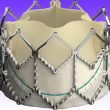In patients with large and extra-large annuli, transcatheter aortic valve replacement (TAVR) is safe and feasible with 3rd generation valves: the 29mm balloon expandable valve Sapien-3, and their competitor, the self-expandable 34mm Evolut R. The largest size of both devices was designed specifically for patients with large or extra-large annuli. However, one of them seems...
Valve-in-Valve: Good Evolution at Long-Term
Courtesy of Dr. Carlos Fava. In the last decades, there has been a marked increase in the use bioprosthetic valves in aortic position given their benefits over mechanical valves. However, long term follow-up has shown structural valve degeneration (SVD). Given the risk of a second surgery after TAVR, valve-in-valve (ViV) has been on the rise,...
Two-Stent Strategy is Safer in True Bifurcation Lesions
Courtesy of Dr. Carlos Fava. DES have improved PCI outcomes, but one of its biggest challenges continues to be bifurcations (especially when we have to use two stents, since it’s been associated to higher restenosis and stent thrombosis rates). Left main coronary artery true bifurcation lesions are the ones that generate the greatest challenge and...
Post TAVR Regression of Ventricular Mass
This study looked at patients with moderate to severe left ventricular hypertrophy and aortic stenosis treated with transcatheter aortic valve replacement (TAVR). Patients with reduced hypertrophy had lower mortality and fewer hospitalizations at 5 years. It included all moderate to severe risk patients with ventricular hypertrophy undergoing TAVR in the studies and registries PARTNER (I,...
The most read scientific articles on interventional cardiology in april
01- ECS Guidelines for COVID-19 Management One of the first statements in this document points out these are not “regular guidelines” developed after thorough analysis of all the available evidence published since the last update. Instead, they are meant to provide temporary basic management pointers on how to handle different scenarios of cardiac patients in the...
SURTAVI Follow-Up Completed with Good News
The assessment of all severe aortic stenosis patients at intermediate risk of the SURTAVI was finally completed, confirming inferiority against the traditional surgical replacement (SAVR) in hard points such as all-cause mortality and disabling stroke. The aim of this study was to report SURTAVI 2-year outcomes (Surgical Replacement and Transcatheter Aortic Valve Implantation) and confirm...
TAVR Reaches Low-Risk Patients with Bicuspid Valves
Transcatheter aortic valve replacement (TAVR) seems to be safe in low-risk patients with bicuspid aortic valve stenosis. Their hospital length of stay was very short, with zero mortality, and zero disabling stroke. Subclinical leaflet thrombosis and device durability are still unknown. The United States Food and Drug Administration (FDA) approved TAVR for low-risk patients. However,...
Technological Improvements in Valves Translate into Clinical Results
Three generations of self-expanding valves, three different prognoses for our patients. Design improvements and better materials in self-expanding, supra-annular aortic valves, and their better results, have allowed for the expansion of the indication for transcatheter aortic valve replacement (TAVR). Particularly, the addition of a pericardial skirt improves annular sealing and results in a significantly low...
Virtual ACC 2020 | First Results of Evolut in Low-Risk Bicuspid Valves
The initial results of this study presented “virtually” at the American College of Cardiology (ACC) 2020 Scientific Session suggest that patients with severe bicuspid aortic stenosis can be treated with self-expandable valve Evolut. This is a small study presenting its 30-day outcomes. There is still a long way to go. The rate of all-cause mortality...
Treating Both Atrial Valves Improves Survival
Courtesy of Dr. Carlos Fava. There a few treatment options for tricuspid valve disease. It is practically limited to diuretics and surgery, is associated to high mortality and, generally, mitral regurgitation. Developing the “edge-to-edge” strategy with MitraClip has been shown beneficial and, at present, there are studies that claim this technique could be greatly beneficial...









